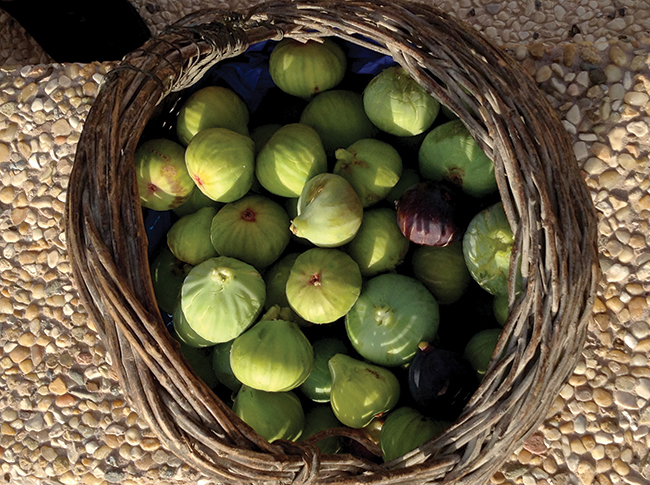
By: Aisha Mansour
Walking through the hisba (produce market) at this time of year, you would never guess that we import our dried figs. Figs are abundant during the mid-to-late-summer season in Palestine. Young boys and more seasoned fallahat (peasant women) are lining the sidewalks in the Al-Bireh hisba to sell their figs. And yet most of the dried figs in our market are imported, mainly from Turkey. Some say that the Turkish version of dried figs is more presentable than our traditional qutein (whole dried figs). Do we really buy the imported for physical appearances, while letting our local baladi fig rot under the tree?! When I learned that the dried figs are imported, I was determined to make my own. While I have nothing against Turkish imports, I don’t think we should be consuming an imported item that is already abundant in our homeland. If you get in the habit of asking about the origin of the products you purchase, you will soon realize that we are importing most of our staples.
While we are still producing good quantities of figs, I am afraid that the fig tree is an endangered species in our country. As I stroll through my hometown in Al-Bireh, more and more orchards are being transformed into cement and stone structures or junkyards. I walked through old Ramallah and Ein Misbah a couple of weeks ago to visit a friend, and there too, orchards are being replaced by apartment buildings. I counted ten buildings under construction. My friend pointed to the new buildings across from her home and explained how multiple fruit-bearing trees existed, including mulberry, fig, and walnut. “Two Ramadan’s ago, I woke up to the sound of my mother screaming as a bulldozer was tearing down old fig, almond, and za’rour (hawthorne) trees that her uncle had planted over 100 years ago. The bulldozer was contracted by the municipality to tear down the trees and widen the road. While the neighborhood has not benefitted from the widened street because large trucks park along the street and close off the additional lane that the municipality insisted on creating, we have lost our shade and our favorite spring and summertime snacks. Couldn’t the municipality have placed a couple of benches around those old trees and created a small park for our neighborhood?”
Our municipalities are creating parks in certain areas, but these parks are full of foreign trees and plants forcing a new habitat. I think most people would agree that we need green spaces in all our neighborhoods. And these green spaces should mimic our natural Palestinian environment and heritage. So why isn’t there a loud outcry demanding that our environment and heritage be preserved?
I worry that future generations will not enjoy the blessings of a fig tree. I first acquainted myself with the fig tree on my first visit to Palestine when I was ten years old. We used to pick figs from the old asaali tree for my aunt whenever she visited, as she loved those asaali figs. I have diabetes and shouldn’t be eating these, she would say. But she always took the bowl of figs home. As an adult, I have learned to enjoy the fig tree all year long, not just during the ripe fig season at the end of the summer. In the fall, the fig tree loses all her leaves. Her bare and winding trunk and branches remain standing tall and firm. As the winter approaches with all its rain, the fig tree provides a unique environment where Palestine’s wild herbs flourish. After a rainy winter, you can find comfrey and loof growing under the fig tree. As spring approaches, the leaves of the fig tree begin to emerge from each branch. They emerge slowly with a little progress each day until the entire leaf materializes. Within a few weeks, the fig tree emits its “scent.” I can’t explain it, but anyone who has lived around fig trees knows what this smell is. It’s the fig tree smell, and it is telling us that fig season is coming.
I pick figs from the old trees planted by my grandfather, drying whatever I cannot consume fresh. Unlike other fruit-bearing trees, the figs on the fig tree do not ripen all at once. The figs ripen gradually, allowing us to enjoy the fruit for two to three months every year. Larger fig trees will provide you with a bowl of fresh figs at least every other day. What a blessing!
Even if you don’t have your own fig tree, you can support our fellaheen (peasants/farmers) and purchase their figs and dry them for eating in the winter. Dried figs will provide you with a delicious sweet treat all year long, and especially when there is no Palestinian fruit in season.
How to dry figs:
- Remove the stems.
- Slice each fig in half.
- Place halved figs on a large tray and cover with a fine-mesh cloth to keep the bugs out.
- Set the tray on your roof in the sun.
- That’s it. It is that easy!
Since we are blessed with so many evenings of dew that moistens our soil and rejuvenates our garden from the day’s harsh sun, it is important to bring the tray of figs inside every evening. Depending on the sun and clouds, it will take three to five days for the figs to dry. Once dried, stuff them into a clean glass jar. Keep your jars of dried figs in a cool and dry cabinet. The dried figs also make great gifts.
When possible, forgo the imported. Eat local! Eat baladi! And preserve the abundance for the not-so-abundant times of the year.
Aisha Mansour spends her free time growing food and caring for her chickens and baladi dog, Sam. She blogs at: www.seasonalpalestinian.wordpress.com.
